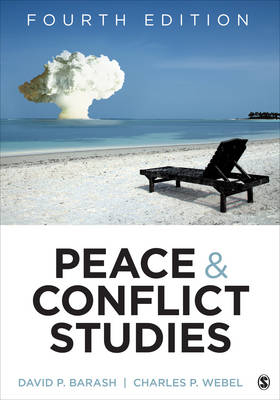
Peace and Conflict Studies
SAGE Publications Inc (Verlag)
978-1-5063-4422-5 (ISBN)
- Titel erscheint in neuer Auflage
- Artikel merken
The thoroughly updated Fourth Edition of the gold standard text explores historical and current topics in today’s rapidly changing world to provide a comprehensive introduction to peace and conflict studies. The authors offer an insightful analysis of 21st-century global affairs, including such timely topics as ISIS, the nature of violence and nonviolence, cutting-edge military technologies, the Terrorism and Global Peace Indexes, and the latest developments in Iran, North Korea, and Syria. Comprehensive yet written in a student-friendly and accessible style, the text represents a commitment to inspire readers to create a better world through an understanding of what has happened and what is happening, and therefore what is likely to take place in the future.
David P. Barash (PhD, University of Wisconsin) is a professor of psychology emeritus at the University of Washington. His studies span animal behavior, evolution, and social psychology, with concentrations in sociobiology, psychological aspects of the arms race and nuclear war, and peace studies. A prolific author and researcher, he has written more than 270 technical articles and 40 books ranging from monographs to college textbooks to popular trade titles. His book Introduction to Peace Studies (1991) was the first comprehensive undergraduate textbook in the field of Peace Studies. His book Threats: Intimidation and its Discontents (2020, Oxford University Press), is especially concerned with debunking nuclear deterrence. Charles P. Webel (PhD, University of California, Berkeley) is presently a professor of international relations and philosophy at the University of New York in Prague. He previously held the Delp- Wilkinson Chair in Peace Studies at Chapman University. A five-time Fulbright Scholar and graduate of the Psychoanalytic Institute of Northern California, he has conducted postdoctoral research at Harvard University, the Max Planck Institute, and the Universities of Paris, Frankfurt, and Heidelberg. He has also taught in the Peace and Conflict Studies Program at Berkeley, the Honors College of University of South Florida, and at Harvard College. He is the author or editor of many articles and nine books, including the forthcoming The Fate of this World and the Future of Humanity.
Part I: The Promise of Peace, the Problems of War
Chapter 1: The Meanings of Peace
The Meanings of Peace
Positive and Negative Peace
Measuring Peace
The Global Peace Index
Key Findings of the U.S. Peace Index
Culture of Peace
A Final Note on the Meanings of Peace
Notes
Questions for Further Reflection
Suggestions for Further Reading
Chapter 2: Peace Studies, Peace Education, and Peace Research
Peace Studies, War Studies, and Peace and Conflict Studies
Peace Education
The Dimensions of Peace and Conflict Studies
PCS Today
Some Contributions of PCS
The Future of PCS
A Final Note on Peace and Conflict Studies, Peace Education, and Peace Research
Notes
Questions for Further Reflection
Suggestions for Further Reading
Journals
Websites
Chapter 3: The Meanings of Wars
Defining Wars
The Frequency and Intensity of Wars
Historical Trends in War
Modern Weaponry
Cutting-Edge Military Technologies
Has Technology Made War Obsolete?
Wars, Empires, Colonialism, and National Liberation
The Desirability of Peace Versus Justifications for Wars
Social Justice and War
Political Ideologies and Militarism
Is War Inevitable?
Can Nations Change?
The Nature and Functions of Conflict
A Final Note on War
Notes
Questions for Further Reflection
Suggestions for Further Reading
Chapter 4: Terrorism Versus Counterterrorism
What Is Terrorism? Who Are “Terrorists”?
A Brief History of Terrorism
The Historical Tension Between State Terrorism From Above and Nonstate Terrorism From Below
ISIS
State and State-Sponsored Terrorism
Terrorism in the Name of God
The Terrorism Industry and the Mass Media
The Global War on Terrorism
The Victims and Perpetrators of Global Terrorism and Counterterrorism
A Final Note on Terrorism
Notes
Questions for Further Reflection
Suggestions for Further Reading
Chapter 5: The Special Significance of Nuclear Weapons
The Nature of Nuclear Weapons
The Effects of Nuclear Weapons
Nuclear Delivery Systems
Strategic Doctrine: Deterrence
How a Nuclear War Could Start
Nuclear Proliferation
Some New Worries
Some Good News
What Might Be Done
A Final Note on Nuclear Weapons
Notes
Questions for Further Reflection
Suggestions for Further Reading
Part II : The Reasons For Wars
Chapter 6: The Individual Level
Aggression, Drives, and Instincts
Sociobiology and Evolutionary Psychology
Freudian and Post-Freudian Psychoanalytic Theory
“Innate Depravity” and “Human Nature”
Social Learning Theories
Gender, War, and Peace
Prejudice, Images of the Enemy, and Human Needs
Attributions and Just-World Theories of Behavior
Altruism, Aggression, and Reconciliation
The Attractions of War
Inhibitions Against War
Some Issues in Nuclear Psychology
A Final Note on Individual-Level Explanations of Wars
Notes
Questions for Further Reflection
Suggestions for Further Reading
Chapter 7: The Group Level
War: Its Prehistory and Early History
Functions of Nontechnological Wars
Characteristics of Premodern and Nontechnological Wars
Alternatives to Nontechnological Warfare
Underlying Group Processes
Brief Conclusion on Premodern and Nontechnological Warfare
Nations, States, Ethnic Groups, and Nationalism
A Brief History of Nationalist Wars
Types of Nationalist Wars
Nationalist Threats to States
Racial and Cultural Intolerance
Nationalism and the Public Mood
Nationalism and Political Ideology
The Question of “National Character”
A Final Note on Nationalism and Ethnocentrism
Notes
Questions for Further Reflection
Suggestions for Further Reading
Chapter 8: The State Level
Defining the State
State Sovereignty
The State System
Alliances Between States
Realpolitik and Raisons d’État
Internal Cohesion
Arms Races
A Final Note on War and States
Notes
Questions for Further Reflection
Suggestions for Further Reading
Chapter 9: The Decision-Making Level
The Role of Leaders
Crisis Decision Making
Some Issues Regarding Perception and Cognition
A Final Note on Decision Making
Notes
Questions for Further Reflection
Suggestions for Further Reading
Chapter 10: The Ideological, Social, and Economic Levels
Conflicting Ideologies
Population Pressure and Other Social Stresses
Poverty as a Cause of War
Imperialism
The Economic Effects of Wars
The Effects of Military Spending
Cultural Conflicts and the “Clash of Civilizations”
A Final Note on the Reasons for Wars and Peace
Notes
Questions for Further Reflection
Suggestions for Further Reading
Part III: Building "Negative Peace"
Chapter 11: Peace Movements
Popular Attitudes Toward Peace
Attention, Success, and Failure
Historical and Current Perceptions of War
History and Taxonomy of Peace Movements
Interconnections Between Peace and Other Social Movements
Some Internal Debates Within Peace Movements
Some Criticisms of Peace Movements
Maintaining the Momentum of Peace Movements
A Final Note on Peace Movements
Notes
Questions for Further Reflection
Suggestions for Further Reading
Chapter 12: Diplomacy, Negotiations, and Conflict Resolution
Human Conflict
Summitry
A Brief History of Diplomacy
Diplomacy and Military Force
Diplomacy and Realpolitik
Track II Diplomacy
Third-Party Involvement
Negotiating Techniques for Resolving Conflict
Methods of Integrative Bargaining
Additional Negotiating Techniques
A Final Note on Conflict Resolution
Notes
Questions for Further Reflection
Suggestions for Further Reading
Chapter 13: Disarmament and Arms Control
Different Visions of Disarmament
A Brief History of Disarmament
Some Current Agreements
The Nuclear Non-Proliferation Treaty (NPT)
Future Prospects
Some Conventional Arms Abuses and Opportunities
Pitfalls of Arms Control Agreements
Benefits of Arms Control Prospects
Economic Conversion
A Final Note on Disarmament and Arms Control
Notes
Questions for Further Reflection
Suggestions for Further Reading
Chapter 14: International Cooperation
The United Nations
Limitations on the UN′s Use of Force
Other Functions of the United Nations
Functionalism
Regional Organizations
World Government?
A Brief History of Plans for World Government
Pros and Cons of World Government
The Dream of World Government: A Waste of Time?
The Prospects for World Government
The Uniting of the United States of America: A Rehearsal for a Global Federal System?
Toward World Government?
A Final Note on International Cooperation
Notes
Questions for Further Reflection
Suggestions for Further Reading
Chapter 15: Peace Through Strength?
Balance of Power
Problems With Balance of Power
The Rise of the BRICS
Collective Security
National Security via Military Force
Appeasement, Provocation, and Deterrence
The Use and Abuse of Threats
The Prisoner’s Dilemma
Sanctions
Nonprovocative Defense
A Final Note on Peace Through Strength
Notes
Questions for Further Reflection
Suggestions for Further Reading
Chapter 16: International Law
The Sources of International Law
Enforcement of International Law
The Conflict between International Law and State Sovereignty
Hidden Strengths of International Law
The Law of War
A Final Note on International Law
Notes
Questions of Further Reflection
Suggestions for Further Reading
Chapter 17: Ethical and Religious Perspectives
Ethics
Religious Attitudes Toward War
Christian “Realism”
Religious Pacifism
Nuclear Ethics
A Final Note on Ethics and Religion
Notes
Questions for Further Reflection
Suggestions for Further Reading
Part IV: Building Positive Peace
Chapter 18: Human Rights
A Brief History of Human Rights
Women’s Rights
Some Human Rights Controversies
Refugees
LGBT Rights
The Legal Status of Human Rights
Human Rights and the Nation-State
Human Rights and Peace
Competing Conceptions of Human Rights
The Responsibility to Protect
Promoting Human Rights
A Final Note on Human Rights
Notes
Questions for Further Study
Suggestions for Further Reading
Chapter 19: Ecological Well-Being
Enhanced Environmental Awareness
The Environment and National Security
The Tragedy of the Commons
Some Major Environmental Problems
Some Environmental Principles
Environmental Activism
Struggling for Sustainability
Resource Wars
Environmental Ethics
A Final Note on Ecological Well-Being
Notes
Questions for Further Reflection
Suggestions for Further Reading
Chapter 20: Economic Well-Being
The Problem of Poverty
Socioeconomic Development
Ethics, Equity and a Bit of History
Hunger
Measuring Wealth, Poverty, and Income Inequality
Population
The Demographic-Economic Environmental Trap
Future Directions
The Case of Costa Rica
A Final Note on Economic Well-Being
Notes
Questions for Further Reflection
Suggestions for Further Reading
Chapter 21: Movements Toward Democracy
What Is Democracy?
A Brief Modern History of Democratization
Democracies and Wars
Can Democracy Be Exported? Should It Be?
A Final Note on Movements Toward Democracy
Notes
Questions for Further Reflection
Suggestions for Further Reading
Chapter 22: National Reconciliation
Truth and Reconciliation Commissions
In the Absence of Truthful Reconciliation . . .
TRC Downsides and Caveats
A Final Note on Reconciliation
Notes
Questions for Further Reflection
Suggestions for Further Reading
Chapter 23: Nonviolence
What Is Nonviolence?
Violence
Nonviolent Peace Theorists and Theories
Mohandas K. Gandhi
Gandhian Nonviolence in Theory and Practice
Martin Luther King, Jr. and the U.S. Civil Rights Movement
Some Nonviolent Successes
Civilian-Based Defense
Does Nonviolence “Work”? If So, Why?
Prospects for Nonviolence
A Final Note on Nonviolence
Notes
Questions for Further Reflection
Suggestions for Further Reading
Chapter 24: Toward a More Peaceful Future
Transformations of Self and Society
Toward the Future
A Final Note on Transformation and the Future
Notes
Questions for Further Reflection
Suggestions for Further Reading
| Erscheinungsdatum | 16.02.2017 |
|---|---|
| Verlagsort | Thousand Oaks |
| Sprache | englisch |
| Maße | 177 x 254 mm |
| Gewicht | 1250 g |
| Themenwelt | Geisteswissenschaften ► Psychologie ► Allgemeines / Lexika |
| Geisteswissenschaften ► Psychologie ► Sozialpsychologie | |
| Recht / Steuern ► Strafrecht ► Kriminologie | |
| Sozialwissenschaften ► Politik / Verwaltung ► Europäische / Internationale Politik | |
| Sozialwissenschaften ► Soziologie | |
| ISBN-10 | 1-5063-4422-4 / 1506344224 |
| ISBN-13 | 978-1-5063-4422-5 / 9781506344225 |
| Zustand | Neuware |
| Haben Sie eine Frage zum Produkt? |
aus dem Bereich



